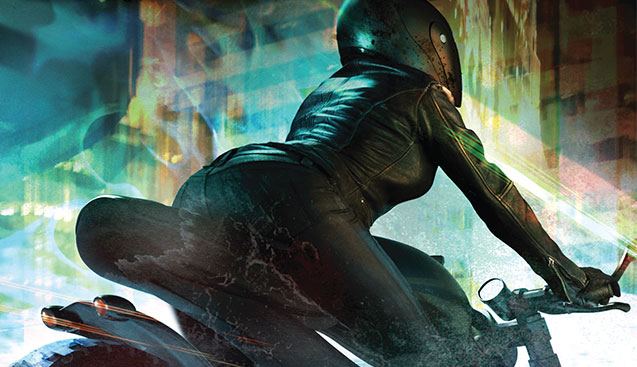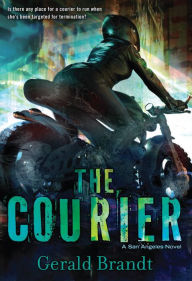The Courier Brings Cyberpunk Roaring Back to Life
 If cyberpunk novels share one common theme, it’s this: in not a one of them is the future any better than the present. Between the sprawling cities, the malevolent artificial intelligences, the deadly designer drugs, and planet-wide pollution, the future’s so dim, night vision googles will be de regueur. Gerald Brandt’s roaring debut The Courier certainly fits the mold, pulling time-tested tropes from the dystopian bag of tricks and twisting them into exciting new shapes.
If cyberpunk novels share one common theme, it’s this: in not a one of them is the future any better than the present. Between the sprawling cities, the malevolent artificial intelligences, the deadly designer drugs, and planet-wide pollution, the future’s so dim, night vision googles will be de regueur. Gerald Brandt’s roaring debut The Courier certainly fits the mold, pulling time-tested tropes from the dystopian bag of tricks and twisting them into exciting new shapes.
Death by urban sprawl
Much of cyberpunk falls under the simple heading of dystopia: a future where it isn’t natural forces or outside influences that doom us, but our own tendency towards entropy. Enter The Courier: in the future, a megalopolis called San Angeles stretches from San Diego to San Francisco. The merging of those cities over time forced people to build up—seven levels up, in fact, the upper reaches filled with light and comfort and the lower depths becoming gradually poorer and more oppressive until you get to Level One. Let’s just say you don’t want to go to Level One. Ever.
The Courier
The Courier
Hardcover $25.00
The courier
Sixteen-year-old Kris is a runaway making her way in this corporation-dominated world (there are references to past Corporate Wars, each corporation has its own private army, and it’s an open secret that the politicians are owned by corporations). Fleeing an abusive uncle, Kris survived Level One on her own long enough to get a job as a courier, part of a human data trafficking operation that exists outside of the too-easily-hacked networks.
Kris is damaged goods, and affects a tough persona as a defense mechanism—she’s had to, in order to survive and to evade the roaming hands of men who see her as vulnerable—but Brandt never loses sight of the fact that for all she’s been through, Kris is still, in many ways, a teenager. When she’s given a mysterious package to deliver and stumbles upon on an assassin named Quincy gruesomely murdering her delivery, Kris barely escapes with her life—and the package.
Non-stop
Kris is rarely without her trusty, grungy motorcycle in this nearly non-stop action adventure. Initially, we’re as mystified as Kris as to the mystery afoot, and the first section of the book is dedicated to Kris’ breathless plunge into the lower city, as she uses all her hard-won knowledge to survive, racing from one attempt on her life to another. Her confusion and desperation send her zipping across a labyrinthine urban landscape, letting us explore the dark areas of the mega-city until we understand just how close Kris is to being crushed under its weight.
Kris is recruited by an anti-corporate resistance called ACE, who want to keep the package out of corporate hands, and quickly begins to rise through the ranks—literally, as she ascends to the city’s higher levels and catches glimpses of how the 1 percent lives (not to mention her first disorienting vision of the sky). She teams up with Miller, a hyper-competent ACE operative who quickly comes to regard her as much more than an asset, even as he wrestles with her relatively young age and vulnerability. Meanwhile, shifting points of view flesh out the universe and reveal why everyone is so desperate to get at the package Kris is carrying.
Evil, Inc.
The villains pursuing Kris (and, eventually, Miller) are extremely well developed, split between the killing fields of San Angeles’ lower levels and pristine board rooms, where corporate skulduggery is no less deadly that a gun at your back. On the ground, Kris is chased by Quincy, a frightening psychopath willing to ignore orders and cross his corporate masters in order to play a horrifying game with her; and Abby, a cooly competent killer who never suffers a single moment of panic or hesitation. Even scarier: these terrifying characters are just tools—the real villains are in the “Sat Cities” high above earth, relaxing in well-appointed offices and moving the pieces around on the board. It’s only when Kris has survived long enough—and done enough damage—to draw the executives down to the surface that the story careens towards a bloody, surprising conclusion.
The Courier is lean and mean as Kris’s rugged ride, ripping through plot and world-building at a relentless pace, which makes its quieter and more contemplative moments all the more striking, giving us just enough time to catch our breath before Kris has to hop on her bike again and get moving. Brandt has created a darkly gripping vision of the future, and we hope to explore the strata of San Angeles in many more novels to come.
The Courier is available March 1.
The courier
Sixteen-year-old Kris is a runaway making her way in this corporation-dominated world (there are references to past Corporate Wars, each corporation has its own private army, and it’s an open secret that the politicians are owned by corporations). Fleeing an abusive uncle, Kris survived Level One on her own long enough to get a job as a courier, part of a human data trafficking operation that exists outside of the too-easily-hacked networks.
Kris is damaged goods, and affects a tough persona as a defense mechanism—she’s had to, in order to survive and to evade the roaming hands of men who see her as vulnerable—but Brandt never loses sight of the fact that for all she’s been through, Kris is still, in many ways, a teenager. When she’s given a mysterious package to deliver and stumbles upon on an assassin named Quincy gruesomely murdering her delivery, Kris barely escapes with her life—and the package.
Non-stop
Kris is rarely without her trusty, grungy motorcycle in this nearly non-stop action adventure. Initially, we’re as mystified as Kris as to the mystery afoot, and the first section of the book is dedicated to Kris’ breathless plunge into the lower city, as she uses all her hard-won knowledge to survive, racing from one attempt on her life to another. Her confusion and desperation send her zipping across a labyrinthine urban landscape, letting us explore the dark areas of the mega-city until we understand just how close Kris is to being crushed under its weight.
Kris is recruited by an anti-corporate resistance called ACE, who want to keep the package out of corporate hands, and quickly begins to rise through the ranks—literally, as she ascends to the city’s higher levels and catches glimpses of how the 1 percent lives (not to mention her first disorienting vision of the sky). She teams up with Miller, a hyper-competent ACE operative who quickly comes to regard her as much more than an asset, even as he wrestles with her relatively young age and vulnerability. Meanwhile, shifting points of view flesh out the universe and reveal why everyone is so desperate to get at the package Kris is carrying.
Evil, Inc.
The villains pursuing Kris (and, eventually, Miller) are extremely well developed, split between the killing fields of San Angeles’ lower levels and pristine board rooms, where corporate skulduggery is no less deadly that a gun at your back. On the ground, Kris is chased by Quincy, a frightening psychopath willing to ignore orders and cross his corporate masters in order to play a horrifying game with her; and Abby, a cooly competent killer who never suffers a single moment of panic or hesitation. Even scarier: these terrifying characters are just tools—the real villains are in the “Sat Cities” high above earth, relaxing in well-appointed offices and moving the pieces around on the board. It’s only when Kris has survived long enough—and done enough damage—to draw the executives down to the surface that the story careens towards a bloody, surprising conclusion.
The Courier is lean and mean as Kris’s rugged ride, ripping through plot and world-building at a relentless pace, which makes its quieter and more contemplative moments all the more striking, giving us just enough time to catch our breath before Kris has to hop on her bike again and get moving. Brandt has created a darkly gripping vision of the future, and we hope to explore the strata of San Angeles in many more novels to come.
The Courier is available March 1.
